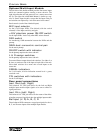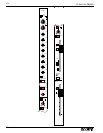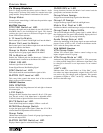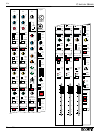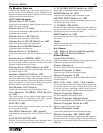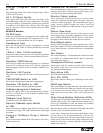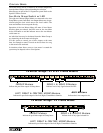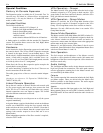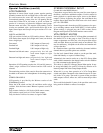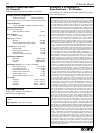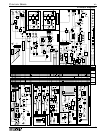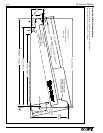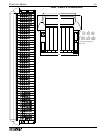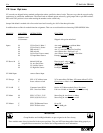
CENTURY SERIES
VX
PAGE 25
Special Facilities (cont'd)
LCR PANNING
Operation of center-cluster sound systems requires panning
channels between the Left and Right sides of the main stereo
PA and between the stereo PA and the center system.
Conventional panning systems allow for L-R panning but the
center feed is either all on, full center, or all off, no center. In
practice it is necessary to balance the different sound groups
between center and sides. This requires LCR panning. Active
circuits are combined with a special multi-section pot in the
Input, Stereo Input and Group-to-mix pan sections of Vx con-
soles.
INPUTS and GROUPS
LCR pan sections include an LCR enable selector. When in
LCR mode, three outputs (Left, Right and Center) are derived
from a single input.
Pan central 100% output to Center only
Pan hard left 100% output to Left only
Pan hard Right 100% output to Right only
Between hard left and center progressively less left and
more center output, no right
output.
Between hard right and center progressively less right and
more center output, no left
output.
Operation of LCR panning requires the L-R and M (mono or
center) assign switches to be selected and the LCR switch
selected.
The monitoring section of the console allows the center mix to
be added to the stereo mix in headphones for checking purpos-
es.
STEREO CHANNELS
LCR panning is provided by the Balance section of the
Width/Balance control.
Select the LCR switch and the L-R and Mono audio assign
switches. Now the inner control 'Balance' operates as an LCR
panpot:
Fully counter-clockwise = full level to L&R, none to center,
50% rotation = equal levels to L, R & Center outputs,
Fully clockwise = full level to center, no signal to L&R
STEREO PROGRAM INPUT
(located above the MONO Master)
Connections are provided on the rear panel for stereo input to
the Mixes, Auxiliaries and Matrix outputs. Use this section for
music playback or special return input. Access to the Matrix
outputs is direct, bypassing the groups. On each Matrix that
requires Stereo input select the switch next to the level control
pot 'L-R / STR PGM'.
Stereo Program audio from the rear XLR connectors also pass-
es to switching contacts on the TAPE INPUT 1/4 inch sockets.
When nothing is plugged into the TAPE sockets Stereo
Program audio passes to the TAPE monitor source switch.
VCA GROUP MUTES
Normally the operation of the VCA Group Mute commands all
the channel VCAs in the group to close. The effect is that all
output assignments are faded out, also the post-fader effects
sends are faded. However pre-fader sends are un-affected. This
may be satisfactory, it depends on the effects and monitor mix
set-up at the time.
In a situation where a pre-fader send had to be muted with the
channel then two possible options are available.
Use the local channel Mute switch to cut the pre-fader send,
either individually or as part of a Mute Group.
Alternatively the console can be set so that VCA Group Mute
sends a Mute command to the channel audio switch in addition
to a fade command to the channel VCA.
This choice is called VCA Group Channel Mute option. It may
be set up individually for each VCA Group by selection of an
internal jumper link in the Group Output module.
When this is set up, then operation of a VCA Group Mute
switch sends Mute commands to the channel mutes of all chan-
nels in the VCA group. The result is to turn off the post-fader
audio outputs to buses, effects etc, AND to mute the pre-fader
sends.
This would be desireable if some of the pre-fader sends were
being used for foldback or effects for example.



